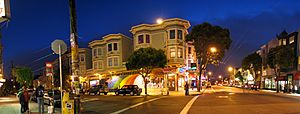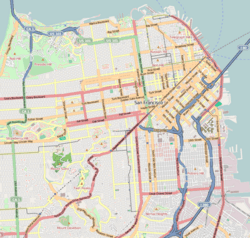Haight-Ashbury facts for kids
Quick facts for kids
Haight-Ashbury
|
|
|---|---|

Cole Street, left, and Haight Street, right
|
|
| Nicknames:
The Haight, Upper Haight, Hashbury, Psychedelphia
|
|
| Country | |
| State | |
| City and county | San Francisco |
| Area | |
| • Total | 0.309 sq mi (0.80 km2) |
| • Land | 0.309 sq mi (0.80 km2) |
| Population | |
| • Total | 10,601 |
| • Density | 34,253/sq mi (13,225/km2) |
| Time zone | UTC−8 (Pacific) |
| • Summer (DST) | UTC−7 (PDT) |
| ZIP code |
94117
|
| Area codes | 415/628 |
Haight-Ashbury is a famous neighborhood in San Francisco, California. It gets its name from where Haight Street and Ashbury Street cross. People also call it The Haight or The Upper Haight. This area is well-known for being a major hub of the 1960s counterculture movement.
Contents
Exploring the Haight-Ashbury Neighborhood
This district covers the area around Haight Street. To the west, it borders Stanyan Street and Golden Gate Park. On the north, you'll find Oak Street and the Golden Gate Park Panhandle. Baker Street and Buena Vista Park are to the east. To the south are Frederick Street, Ashbury Heights, and the Cole Valley neighborhoods.
The streets are named after important early San Francisco leaders. Henry Haight was a pioneer and banker. Munroe Ashbury was a member of the San Francisco Board of Supervisors from 1864 to 1870. Both men helped plan the neighborhood and nearby Golden Gate Park when it was first created. Locals sometimes use "Upper Haight" to tell it apart from the Haight-Fillmore or Lower Haight areas.
Before the 1960s, a group called the Beats gathered in San Francisco's North Beach neighborhood. When North Beach became too crowded, many moved to Haight-Ashbury. It was a charming, affordable, and less crowded place to live.
Haight-Ashbury later became famous as a main center for the hippie movement. The Summer of Love in 1967 and much of the 1960s counterculture are still strongly linked to San Francisco and the Haight-Ashbury area.
History of Haight-Ashbury
Early Days and Growth
Before 1883, Haight-Ashbury was mostly farms and sand dunes. That year, the Haight Street Cable Railroad was finished. This cable car line connected the east side of Golden Gate Park to downtown San Francisco.
Because it was a main entrance to Golden Gate Park, the area became a popular spot for fun. An amusement park called the Chutes was on Haight Street from 1895 to 1902. Also, the California League Baseball Grounds stadium opened in 1887. These attractions made the area a busy entertainment spot, especially on weekends.
In the late 1800s and early 1900s, new building methods and the cable car helped change Haight-Ashbury. It became a neighborhood of homes for the upper middle class. It was also one of the few areas that avoided major fires after the huge San Francisco earthquake in 1906.
Changes During the 20th Century
The Great Depression in the 1930s hit Haight-Ashbury hard. Many people who could afford it moved to newer, less crowded areas. During World War II, the large Victorian and Edwardian houses were split into smaller apartments. This helped house workers coming to the city. Some homes also became boarding houses.
By the 1950s, the neighborhood was not as well-kept. Many buildings were empty after the war. Middle-class families continued to move to the suburbs. This left many apartments available for rent.
The 1960s and Beyond
In the 1950s, there was a plan to build a freeway through the Panhandle area. However, citizens protested against it. This "freeway revolt" lasted until 1966 and stopped the project. The Haight Ashbury Neighborhood Council (HANC) was formed during this time in 1959.
Because property values had dropped due to the freeway plans, the beautiful 19th-century houses became affordable. This made Haight-Ashbury a perfect place for hippies in the 1960s. They found cheap rooms and empty properties to rent or buy. The unique culture that grew there became famous and still has an influence today.
After 1968, the area faced some challenges. However, it improved and was renewed in the late 1970s. In the 1980s, Haight-Ashbury became a center for comedy in San Francisco. A small coffee shop called The Other Café in nearby Cole Valley became a comedy club. It helped start the careers of famous comedians like Robin Williams, Dana Carvey, and Whoopi Goldberg.
Fun Things to Do in Haight-Ashbury
One popular event is the Haight-Ashbury Street Fair. It happens every year on the second Sunday in June. Thousands of people come to enjoy it. During the fair, Haight Street is closed to cars between Stanyan and Masonic streets. There are also music stages at each end of the street.
See also
 In Spanish: Haight-Ashbury para niños
In Spanish: Haight-Ashbury para niños



